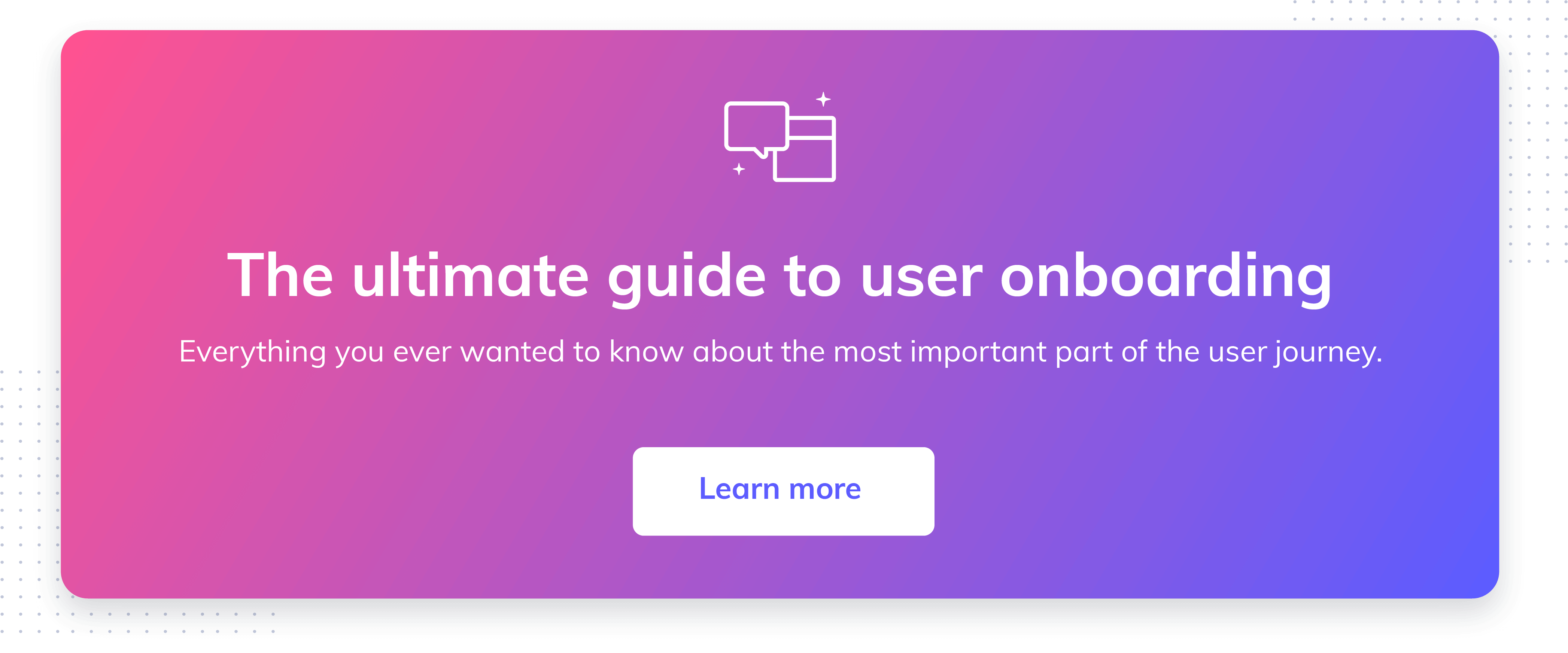Your how-to guide for persona-based user onboarding

.png)

.png)
I’ve been raving about our user onboarding process for months now—and sometimes people really think I’m making up how awesome it is.
But not only has it shortened our users’ activation time from 6 weeks to 10 days, it’s allowed us to improve our overall customer experience tenfold. Ok, that last part may be a bit of an exaggeration, but I’m allowed to brag a little, right?
Beyond just improving our user’s experience, we’ve also seen some wonderful unexpected side effects.
But how did we do this?
Here are a few tips you can apply to your own onboarding!
I say this time and time again—know who you’re speaking to.
Know your place in the market—who your users are and what the best way of talking to them looks like. Some people like to talk about product-market fit, but I like to think of it as market-product fit. Figure out your market, then figure out how you’re going to develop and talk about your product to them.
In our case, our main target audience are product managers.
Product managers are too smart for your typical sales tactics. They certainly don’t like being sold to, and they definitely know when you’re trying to market at them.
To balance that, we make sure that all of our emails are written in a very specific tone of voice: conversational, personal, and ditching all sales tactics.
Instead of trying to “sell”, we focus on providing guidance. We are there to have a human-to-human conversations, not to push upgrades that may be completely unnecessary.
Knowing your audience is important, but catering to your audience is the next step up.
We already know how we want to talk to users, but what we are going to talk to them about is a different thing.
Our onboarding is based entirely around specific actions a user takes. Based on those actions, we then recommend the next steps that need to be taken—focusing on the specific needs for the user.
Why?
Because at the end of the day, you only have a small timeframe to make first impressions. Don’t waste it! Make those interactions count, and think about how specific can you get before your automation setup looks more like a kraken than a successful CRM funnel.
Kathy Sierra refers to this in her book, Badass: Making Users Awesome. She says, “Make people better at something they want to be better at.”
By recommending the next steps to take based on what they’ve already done, we create a more personal experience.
Take your time and map out a flow of what your user journey looks like:
Our own flow is based on specific actions that we have studied overtime. We know that there are certain actions that will result in a higher conversion rate and quicker understanding and adoption of the application, so we very subtly push the user towards engaging with those power features first.
Based on that, our goals when setting up our own flow were:
This then shortens the time-to-conversion, provides value a lot faster, and triggers a reward for our client: finding a solution to the problem they were having.
One thing that’s always been at the forefront of my own learning experience is that people learn in different ways. Some people are visual and enjoy videos, some people enjoy reading (and others never read their emails!), and some people learn by just doing.
When thinking of ways to improve your onboarding, don’t limit yourself to just one option!
There isn’t a single way or a single medium that’s the correct one, which is why we actually chose to tackle them all. Here’s what we did in each:
Our emails are specific based on actions users have specifically taken within the app, and we regularly have checks on what users have done (or not done) to guide them towards a particular step to tackle on next.
Like our emails, our app guides users towards completing key steps.
These steps aren’t forced in any particular order, but we do highlight them and make it obvious that there are first 3 steps that they need to complete (our ‘power features’) followed by secondary key steps which are tied to their trial extension.
Trial time in our app extends based on those actions, with some worth more days than others. The more time the user unlocks, the more invested they’ve become, and the more likely they are to sign up.
To cater to our more visual users, we have about 30 videos, each 30 seconds to 2 mins long. They explain each key area of the app, including how and why they are important. They’re really a success!

I can’t say this enough: Building a personal relationship is key.
We’ve ramped up the amount of demos that we offer, and we can already see great results from them. We've found that users who engage personally with someone in the team are twice as more likely to sign up for a larger subscription than those that go through the onboarding process on their own without any help.
Personalization goes beyond just adding a first name to an email. It is understanding your user’s journey and catering to the specific needs they have to ensure they are successful, both in using your app, but also at their jobs.
Our goal isn’t just to sell ProdPad, but to be the tool that also helps product managers be better at what they do, and communicate that value to the user.
Our in-app guidance as well as our emails guide the user towards completing steps that will shorten the time-to-conversion and provide value a lot quicker. Our videos and webinars allow us to talk to our users directly and give us the opportunity to create a personal relationship, giving us that extra little edge in catering to that experience and speak to people on a more human level.
Too much too fast?
Don’t worry! You don’t have to get it all right on day one. If you can't tackle all items at once, prioritize a few and build out slowly. Get your team to support you, you’re not meant to be doing all of this on your own. I like to think of customer experience and success as something that the entire team should be aiming to do together.
If there is anything I want you all to take away from this, it’s the importance of getting to know your users. Don’t treat everyone like they fit in a single box. Have meaningful conversations, take in feedback, and iterate as you go.
